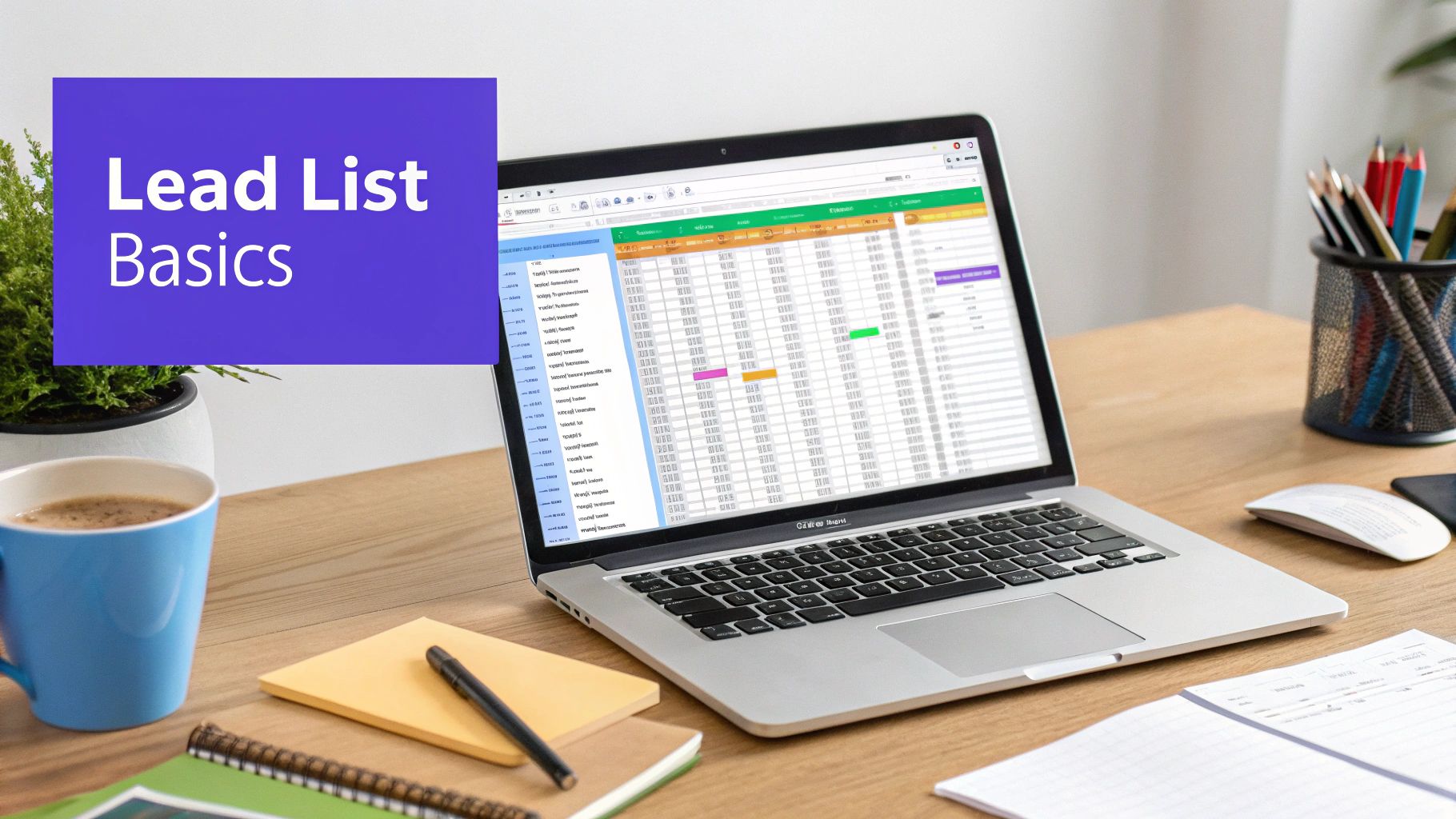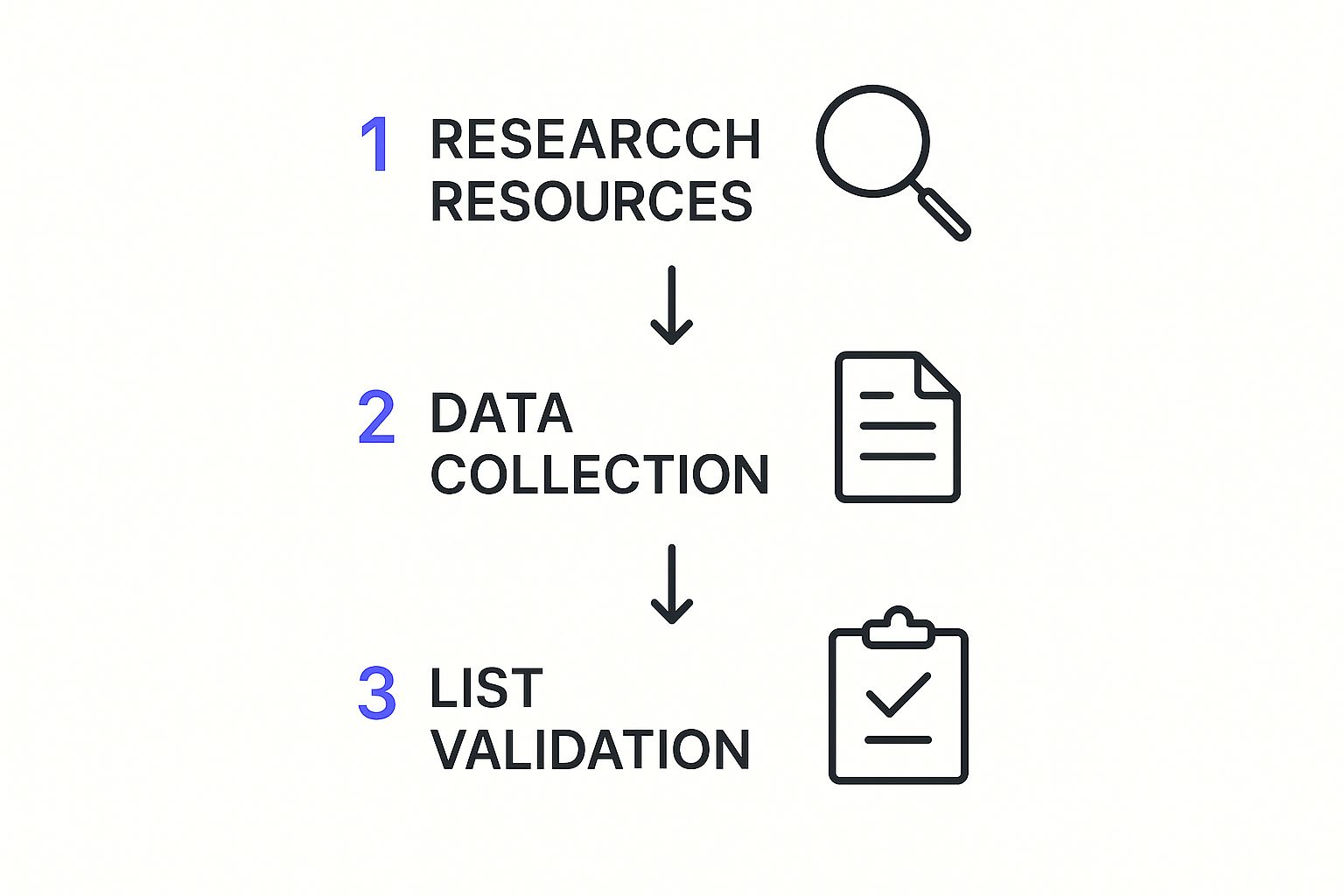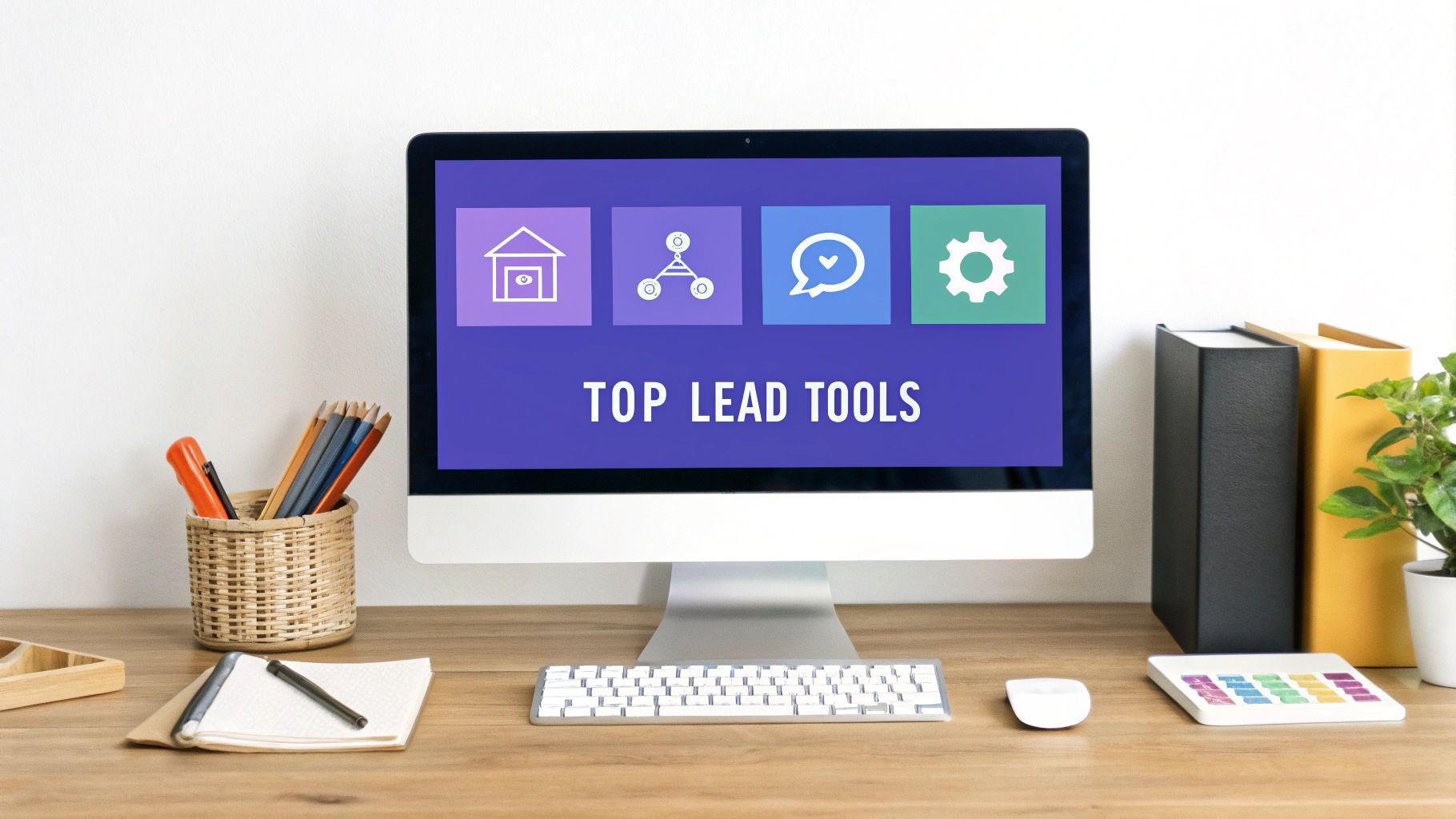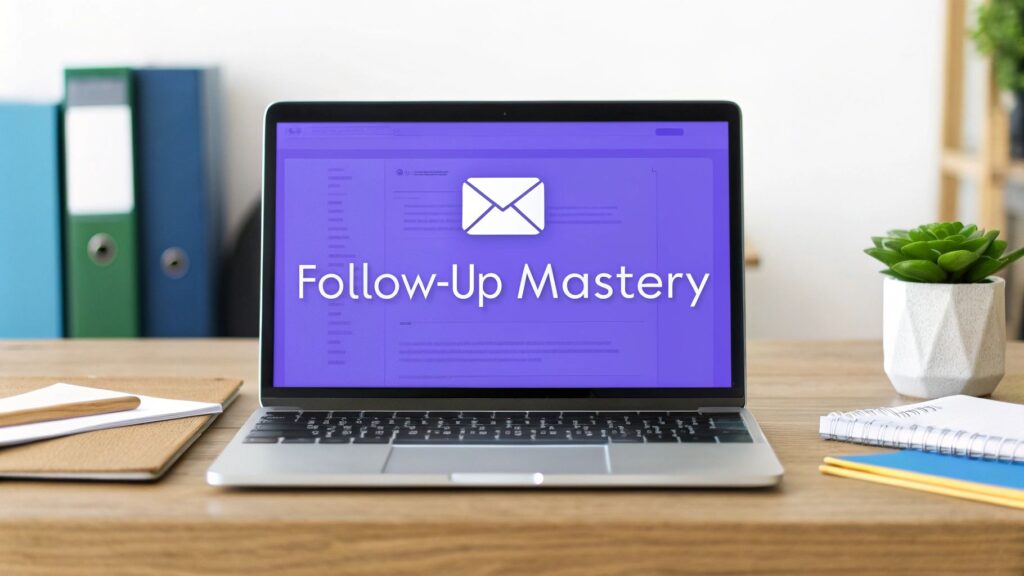Build a Powerful Business Lead List Today

A business lead list isn’t just a random collection of names and emails. It's a carefully curated directory of potential customers—people and companies that perfectly match your ideal client profile. The real goal here isn't about sheer volume; it's about precision and relevance. A study by Gartner found that sales reps spend nearly a third of their time on low-value activities, and a poor lead list is a major contributor. Every single contact should represent a genuine opportunity to win a new customer.
Laying the Groundwork for a Quality Lead List

Before you even think about building your list, you have to know exactly who you're building it for. I've seen countless teams jump straight into data collection without a clear target, and it's a classic mistake. It’s like sailing without a map—you’ll feel busy, but you won't get anywhere meaningful.
The absolute first step is to create a detailed Ideal Customer Profile (ICP). This is the blueprint for the perfect company you want to sell to. It goes way beyond basic demographics, forcing you to pinpoint the specific traits that signal a fantastic fit for your product or service. This isn't just a paperwork exercise; it's the strategic core of your entire lead generation engine.
Defining Your Ideal Customer Profile
A truly strong ICP is built on hard data, not just hunches or guesswork. The best place to find that data? Your own backyard. Start by analyzing your most successful existing customers—the ones with the highest lifetime value, lowest churn, and who are advocates for your brand. Look for the common threads that tie them together. What makes them your best clients? Is it their industry, their size, their tech stack?
When you dig into your best accounts, you'll start to see patterns across a few key areas. I’ve put together a table to show you exactly what to look for and, more importantly, why it matters.
Key Components of a Strong Ideal Customer Profile (ICP)
| Data Category | Example Data Points | Why It Matters |
|---|---|---|
| Firmographics | Industry (e.g., FinTech, Healthcare), company size (100-500 employees), annual revenue ($10M-$50M), location (North America) | These are the foundational filters that help you narrow the market down to a manageable and relevant segment. For instance, knowing a company's revenue can signal its budget for new solutions. |
| Technographics | CRM (e.g., Salesforce), marketing automation (e.g., HubSpot), cloud provider (e.g., AWS), programming languages | Knowing their tech stack tells you if your product can integrate and whether they're sophisticated enough to be a good fit. It also reveals potential competitive replacement opportunities. |
| Behavioral Data | Recently received funding, hiring for specific roles (e.g., "Head of Sales"), expanding to a new market, high website engagement | These are buying signals. A company hiring a new sales leader is probably looking for sales tools. It's a clear trigger event that indicates an immediate need. |
This process helps you understand not just who to target, but why they are a good fit, which is crucial for crafting a message that resonates.
A well-defined ICP transforms your outreach from a speculative "spray and pray" tactic into a targeted, strategic campaign. It ensures that every lead you pursue has a high probability of needing what you offer, dramatically improving your conversion rates.
The Impact of Precision on Sales
It's no surprise that lead generation remains the top priority for marketers—a massive 91% rate it as their number one goal. But here’s the reality check: 44% of sales reps say they’re too buried to follow up on leads, and a mind-boggling 97% of potential customers ignore cold calls.
These numbers scream one thing: quality over quantity. A precise ICP acts as a powerful filter, preventing your sales team from wasting precious time on dead-end prospects who were never going to buy anyway. To make sure your approach is solid from the get-go, always stick to proven lead generation best practices. This foundational work is what separates a list that drives consistent revenue from one that just collects dust in your CRM.
Sourcing Leads From Channels That Actually Work
Alright, you've got your Ideal Customer Profile locked in. Now, the real fun begins. It's time to move from theory to action and start hunting for your next best customers.
But let's be clear: this isn't about casting a wide, generic net and hoping for the best. The goal is to focus your energy on the channels that actually produce high-quality prospects, not just a bunch of noise that clogs up your pipeline. A multi-channel approach is your best bet—putting all your eggs in one basket is a quick way to end up with a stale list.
Mastering Professional Networks
When you're in the B2B world, one platform is king: LinkedIn. It’s become an absolute powerhouse for finding decision-makers, with over one billion professionals on the platform. It’s no surprise that 53% of B2B marketers turn to it specifically to find prospects. You can dig into even more stats about LinkedIn's role in B2B marketing on sopro.io.
Just having a profile won't cut it, though. The real magic happens when you use a tool like LinkedIn Sales Navigator. It lets you slice and dice the user base with incredibly specific filters that go way beyond a simple job title search.
For instance, you can zero in on people who match your ICP by looking at:
- Company headcount growth: Are they hiring and expanding? A company with 20% headcount growth over the last year is likely investing in new tools.
- Technologies used: Find companies using software that complements yours (or a competitor's you can replace).
- Keywords in their profile: Uncover people who are actively talking about the exact pain points you solve by searching for terms like "supply chain optimization" or "improving team productivity."
This isn't just about finding names; it's about finding the right names at the right time.
Uncovering Hidden Lead Sources
LinkedIn is a fantastic starting point, but don't stop there. Some of the best leads come from places where people have already shown a little interest or are actively engaged in your industry.
The most powerful leads often come from channels where prospects have already raised their hands, indicating active interest. Tapping into these sources—like event lists or website analytics—shifts your outreach from a cold interruption to a relevant conversation.
Think about digging into these often-overlooked goldmines:
- Industry-Specific Directories: Niche directories are treasure troves. Think of sites like Capterra for software or Thomasnet for industrial suppliers. The companies listed there are actively looking for solutions.
- Virtual Event Attendee Lists: Anyone who sits through a webinar or a virtual conference about your industry is pre-qualified. They're already investing time to learn about the space you're in.
- Website Analytics: Tools like Google Analytics can sometimes show you which companies are browsing your site, even if they never fill out a form. A prospect visiting your pricing page multiple times is a massive buying signal right there.
By pulling contacts from a few different places, you start to build a much richer profile for each prospect. You might spot a company on your website, find the perfect contact person on LinkedIn, and then confirm their needs on an industry directory.
For teams that need to move faster, looking into an outsourced B2B lead generation service can be a game-changer. They can deliver expertly sourced contacts without you having to do all the manual legwork. This kind of smart, strategic discovery is what separates a world-class lead list from a simple spreadsheet of names.
Organizing Your Lead Data for Maximum Efficiency

Sourcing a pile of leads is one thing, but making them useful is another challenge entirely. A messy, disorganized business lead list is a dead end. Your sales team will spend more time trying to figure out what they’re looking at than actually connecting with prospects. The real goal here is to build a single source of truth—a clean, organized system that actually drives action.
It all starts with deciding what information you absolutely need for every single lead. Inconsistency will kill your efficiency faster than anything else, so setting up a standard format from the get-go is non-negotiable. This simple habit ensures everyone on your team is on the same page and makes your reporting infinitely more accurate down the road.
Building Your Data Template
Whether you're starting with a Google Sheet or plugging data into a full-blown CRM, there are some core fields that are the backbone of any good lead list. Each piece of information serves a specific purpose, helping your team personalize their outreach and understand the context of the conversation.
Here are the essentials:
- Full Name: The prospect's first and last name. Simple, but crucial.
- Job Title: Knowing their exact role is key to tailoring your pitch.
- Company Name: The organization they represent.
- Verified Email: You need an email that won't bounce. This is a must.
- Direct Phone Number: Getting a direct line is far better than a generic company number.
- LinkedIn URL: This is your window into their professional world for pre-call research.
- Lead Source: How did you find them? ("LinkedIn," "Webinar," "Referral"). This data is gold for figuring out which of your efforts are actually paying off. For example, you might find that webinar leads convert at twice the rate of directory leads.
This structure gives your team a complete snapshot of a prospect in a single glance. No more hunting around for basic info.
Think of your lead list's structure as the foundation of a house. A weak, inconsistent foundation will cause everything built upon it—your outreach, your follow-ups, your reporting—to eventually crack and fail.
From a Static List to an Active Workflow
A great lead list isn't just a static directory; it’s a living tool for managing your pipeline. The simplest way to make it dynamic is by adding a "Status" column. This small change brings immediate clarity to your workflow, showing you exactly what needs to happen next and preventing good leads from getting lost in the shuffle.
Here’s a simple but effective status framework to get you started:
- To Contact: These are fresh leads, ready for their first touchpoint.
- Engaged: You've made contact and are in an active conversation.
- Nurturing: They're a good fit, but the timing isn't right. You’ll circle back later.
- Disqualified: You've determined they aren't a good fit for what you offer.
This one addition transforms your spreadsheet from a passive list into an active sales playbook. If you're looking to put this on autopilot, checking out some lead generation automation tools can help manage these workflows without the manual busywork. Sticking to this data discipline is the key to making sure no opportunity slips through the cracks.
Turning Raw Data Into Actionable Intelligence
So you've got a list of names and companies. That’s a decent starting point, but it's really just the raw material. To turn that spreadsheet into a genuine sales asset, you have to enrich and verify it. This is the crucial step that separates the amateurs from the pros who build predictable pipelines.
Let's be honest, raw data is full of holes. You might have a name and a company, but you're missing a direct email or a phone number that won't go straight to a gatekeeper. That's where data enrichment comes in. It’s all about filling in those gaps and painting a much clearer picture of who you're trying to reach. Skip this, and your outreach will feel like you're flying blind.
From Basic Data to Rich Profiles
Thankfully, you don't have to spend your days hunting for this information on LinkedIn. Modern enrichment tools were built to do the heavy lifting for you. Platforms like Apollo.io, Clearbit, and ZoomInfo can take a simple data point—like a name and a company website—and flesh it out with the details you actually need.
What kind of details are we talking about?
- Verified Corporate Emails: Direct, role-specific email addresses that actually work.
- Direct-Dial Phone Numbers: The kind that bypasses the front desk and connects you right to the person you need to talk to.
- Firmographic Data: Important context like company revenue, employee count, and even the tech stack they're using.
Imagine you have a lead: Jane Doe at "Acme Corp." An enrichment tool can instantly tell you she’s the VP of Marketing, give you her direct email and phone number, and reveal that her company uses Salesforce and has 200-500 employees. Suddenly, a weak lead becomes a highly qualified prospect you can build a real conversation around.
This whole process—from initial research to a fully validated list—is a flow.

As you can see, validation is the final gate. It’s the last quality check before your team ever hits "send."
Why Email Verification Is Non-Negotiable
Enrichment adds the what, but verification confirms the where. Hitting "send" on an unverified email address is a huge gamble. When it bounces, it’s not just a wasted effort; it actively harms your sender reputation.
Internet service providers (ISPs) are always watching. They track bounce rates closely, and if yours is consistently above 2%, they start flagging your emails as spam. That means even your messages to perfectly valid addresses might never see the light of day.
An unverified email in your business lead list is a hidden liability. Each bounce erodes your sender score, gradually making it harder for all your outreach to reach the primary inbox. Verification isn't just about accuracy; it's about protecting your ability to communicate.
The good news is that the verification process is simple. Tools like Hunter.io or ZeroBounce can quickly check if an email address is active and can receive mail before you reach out. This isn't a one-and-done task, either. B2B marketing data decays at a staggering rate of over 2% per month, which means a significant chunk of your list can go stale in just a year.
Running regular verification checks ensures your messages actually land. It maximizes the impact of your outreach and protects your domain's health for the long run. This is the final step that turns your list from a simple spreadsheet into a reliable, high-performance sales tool.
Segmenting Your List for Personalized Outreach

You've done the hard work of building a clean, enriched, and verified business lead list. It's a huge step. But if you stop there and blast the same generic message to everyone, you’re setting yourself up for failure. That's the fastest way to get ignored.
Before you hit "send," there's one last crucial step: smart segmentation. This is all about breaking down your master list into smaller, more focused groups based on what they have in common. It's not just about staying organized; it's about making your outreach feel like it was written just for them.
The data backs this up. Personalized campaigns can pull in a return on investment of over 120%. It’s pretty clear that people tune out the noise and listen when a message speaks to their specific situation. Segmentation lets you stop shouting one message at everyone and start having a more meaningful conversation.
How to Group Your Leads for Maximum Impact
The real beauty of segmentation is how flexible it is. You can slice and dice your master list in dozens of ways, with each cut creating a new opportunity for a hyper-relevant message. The goal is to group leads using data points that hint at their specific challenges, goals, or day-to-day reality.
Here are a few of the most effective ways I've seen this done:
- By Industry: Pulling all your "FinTech" or "Healthcare SaaS" leads into one bucket lets you use their lingo and talk about the exact problems plaguing their sector. For example, a healthcare message could reference HIPAA compliance.
- By Job Title: You wouldn't talk to a CEO the same way you'd talk to a Director of Marketing. The CEO cares about high-level ROI and strategic vision, while the marketing director is focused on campaign performance and team efficiency.
- By Company Size: A scrappy startup with 20 employees has entirely different growing pains than an enterprise with 2,000. Segmenting by headcount helps you tailor your solution to their scale.
- By Technology Stack: This one is a game-changer. If you know a company uses Salesforce, you can lead by mentioning your direct integration, which makes your pitch instantly more compelling.
This whole process should feel familiar—it’s a natural extension of the work you did when you first learned how to create buyer personas. Think of each segment as a living, breathing version of one of those personas.
Turning Segments Into Precision Outreach
Once your segments are defined, the real magic happens. Now you can craft messages that resonate on a completely different level because they’re built on a foundation of shared context.
Let’s play this out. Imagine you create a super-specific segment: "VPs of Sales at B2B SaaS companies with 100-250 employees using HubSpot."
A generic email might say, "We help companies grow." That's an instant delete.
But with your new segment, you can write something laser-focused: "I saw you're leading the sales team at a fast-growing SaaS company. We've helped other HubSpot users like you cut their sales cycle by 15% with our native integration."
See the difference? It's specific, it’s relevant, and it proves you did your homework.
Segmentation transforms your outreach from a monologue into a dialogue. It proves to the prospect that you understand their world before you ask for a moment of their time, dramatically increasing the likelihood of a positive response.
The demand for this level of precision is only growing. The lead generation market in North America is on track to jump from $1.22 billion in 2021 to a projected $3.62 billion by 2028. You can dig into this impressive growth on GrowthList.co. This isn't just a trend; it's a fundamental shift showing that companies are pouring money into smarter ways to connect, and segmentation is right at the heart of it all.
Answering Your Top Questions About Building Lead Lists
As you get your hands dirty building a high-quality business lead list, you're bound to run into a few common questions. This isn't just a data entry task; it's a strategic process. Getting clarity on the typical roadblocks and best practices can make a world of difference.
Let's tackle some of the most frequent questions we hear from people just like you.
Should I Buy a List or Build My Own?
This is the classic fork in the road, and honestly, it’s one of the most important decisions you'll make. Buying a list seems tempting, right? It promises instant gratification—a massive spreadsheet of contacts delivered to your inbox overnight.
But that shortcut often leads to a dead end. Purchased lists are infamous for being stuffed with outdated, irrelevant, and unverified data. According to one industry report, response rates from purchased lists are often below 0.1%. Think about it: those people have never heard of you, so your outreach is completely cold and, more often than not, unwelcome. It’s a fast track to spam folders and a damaged sender reputation.
Building your own list takes more effort up front, but the payoff is huge. Every single contact is hand-picked because they fit your Ideal Customer Profile (ICP). This means you start with a foundation of quality and relevance. You’re in complete control of the data's accuracy, which leads to better engagement, fewer bounced emails, and genuine conversations.
Buying a list feels like a quick win, but building one is the only way to play the long game. It’s a conscious choice for quality over sheer quantity, and that’s what truly drives effective outreach.
How Often Should I Clean My Lead List?
Here’s a hard truth: business data gets stale, and it happens faster than you think. People switch jobs, companies get acquired, and email addresses die. A well-known study from MarketingSherpa revealed that B2B data decays at a staggering rate of 2.1% per month. That adds up to 22.5% over a single year.
Let that sink in. After just 12 months, nearly a quarter of your carefully built list could be completely useless.
To stay ahead of this decay, you need to make list hygiene a regular habit. Plan to clean your active lead list at least once every quarter. This isn't just about deleting bad contacts; it's about routine maintenance.
- Scrub for duplicates. You don't want to annoy a prospect by emailing them twice.
- Re-verify emails. Before you launch a new campaign, make sure the addresses are still valid.
- Update key details. A quick check for new job titles or company changes keeps your outreach relevant.
If you’re working with a massive list, don't try to do this all by hand. Automated data hygiene tools can be a lifesaver. Consistent cleaning ensures your outreach is always sharp, accurate, and has the best possible chance of landing in the right inbox.
What Are the Legal and Ethical Rules?
Collecting contact info for B2B outreach is perfectly legal, but it’s not the Wild West. You have to play by the rules, which means respecting data privacy regulations like GDPR in Europe and the CAN-SPAM Act in the United States.
The core principle here is legitimate interest. Your reason for contacting someone must be directly relevant to their professional role. You can't just scrape a name and email and start blasting them with unrelated offers. For example, contacting a VP of Marketing about your new marketing automation software is a clear legitimate interest.
Always be transparent. State who you are and why you're reaching out. Most importantly, give every person a crystal-clear, easy way to opt out of future messages. This isn’t just about staying compliant; it's about being a good human and building trust from that very first touchpoint.
Ready to stop chasing cold leads and start engaging high-intent prospects? FundedIQ delivers hand-curated lists of recently funded startups, complete with verified decision-maker contacts and critical buying signals. Get the actionable intelligence your agency needs to win more deals. Explore how we can accelerate your pipeline.





